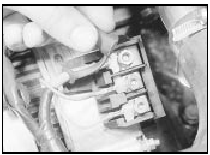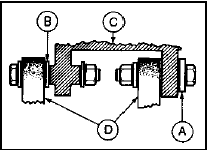Alternator - removal and refitting
Removal
1 Disconnect the battery leads.
2 Disconnect the multi-plug, or disconnect the wires from their terminals on the rear of the alternator, noting their locations (as applicable), then slacken the mounting and adjustment bolts and tilt the alternator towards the engine (see illustrations).

4.2a Disconnecting the multi-plug from a Bosch alternator

4.2b Removing the insulating cap from the main wiring terminal on a Lucas
A127 alternator (CVH model)
3 Remove the drivebelt(s) from the alternator pulley(s).
4 Remove the mounting and adjustment nuts and bolts, and withdraw the alternator from the engine.
Refitting
5 Refitting is a reversal of removal, noting the
following points.
6 To avoid breakage of the alternator mounting bracket lugs, it is important that the following procedure is adhered to when refitting the mounting bolts.
7 Always refit the large flat washer (A) (see illustration).

4.7 Alternator mounting bracket arrangement
A Large flat washer B Small flat washer (models up to 1985 only) C Mounting bracket (engine) D Mounting lugs (alternator)
8 Earlier models (before 1985) also have a small washer (B) which must be fitted between the sliding bush and the mounting bracket.
9 Ensure that the bushes and bolts are assembled as shown - except on 2.0 litre DOHC models where a through-bolt is used, then tension the drivebelt(s) and tighten the mounting and adjustment bolts as shown in the relevant illustration in Chapter 3.
Alternator drivebelt(s) - checking, renewal and tensioning
Refer to Chapter 1, Section 21.
See also:
Front anti-roll bar - removal and refitting
Removal
1 The anti-roll bar is used in conjunction with
the forged type suspension lower arm.
2 Jack up the front of the car and support it
on stands (see “Jacking and Vehicle Support”).
3 Where ...
Accelerator pedal - removal and refitting
The procedure is the same as described in
Part A of this Chapter for carburettor models. ...
Rear suspension front mounting (Saloon, Hatchback and Estate models) -
renewal
1 Chock the front wheels, jack up the rear of
the vehicle and support on axle stands placed
under the side members.
2 Unscrew and remove the three bolts
securing the relevant front guide plate to ...
